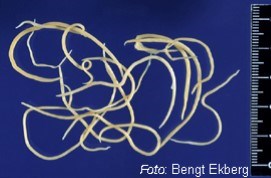Contact
johan.hoglund@slu.se, +46 18 67 2371, +46 70 257 4156

Pathways for roundworm infection
Project responsible: Johan Höglund, Department of Biomedical Sciences and Veterinary Public Health, SLU.
Collaboration: Desiree Jansson, the National Veterinary Institute, SVA
The chicken roundworm (Ascaridia galli) is a nematode parasite, which has increased in prevalence in litter-based housing systems including on organic farms in Sweden in recent years. In this project we are going to investigate key parameters for the development, survival and spread of the parasite eggs under different environmental conditions. Experiments will be performed in the laboratory environment and under simulated field conditions.
We will also investigate the sensitivity of the eggs for disinfectants, and in selected organic herds identify where and to what extent eggs with viable larvae are present. Laboratory experiments will be conducted to study how combinations of various factors, such as temperature, rainfall etc. affect the development and survival of the parasite eggs.
The results will be compared with published data, which are old and need to be complemented. In these studies, we will simulate the real conditions in poultry houses. We will also investigate the effect of freezing and thawing, as well as how egg age influences the development of the eggs into infectious viable stages. Furthermore, we will measure the effects of increasing concentrations of different disinfection or decontamination agents.
Fresh chicken faeces containing parasite eggs will be deposited directly on the ground to investigate seasonal effects. In addition, faeces and soil will be collected on two organic laying hen farms where the laying hens are infected, to identify where ascarid eggs are deposited, develop and survive. Samples will be obtained both before new pullets are introduced and on at least three occasions evenly distributed during the flock's life. Samples obtained before the arrival of pullets will indirectly reflect the effect of pasture rest and various remedial measures that have been introduced by the farmer.
Finally, we will apply a PCR-based subtyping method that may be used in future epidemiological studies.
johan.hoglund@slu.se, +46 18 67 2371, +46 70 257 4156
Tarbiat B, Jansson DS, Höglund J. 2015. Environmental tolerance of free-living stages of the poultry roundworm Ascaridia galli. Veterinary Parasitology 209, 101–107. doi: 10.1016/j.vetpar.2015.01.024
Jansson DS, Morrison D, Engström A, Nejsum P. & Höglund J. 2011. Assessment of genetic relationships among Ascaridia galli from different laying hen farms with AFLP markers. XVII Congress of World Veterinary Poultry Association (WVPA), pp. 586–588. 14–18 August, Cancún, México.
Oral presentations
Jansson, D.S. & Höglund, J. 2013. Efficacy of flubendazole against Ascaridia galli in laying hens. Nordic Poultry Conference, Helsinki, Finland 6–8 November, 2013.
Höglund, J. & Jansson, D.S. 2012. Ascaridia galli – current research activities in Sweden. 1st International Workshop on Ascaridia galli, Hørsholm, 1–2 februari.